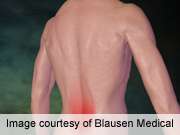Postural sway mediated by low back pain, not fear of pain

(HealthDay)—Changes in postural sway are caused by low back pain (LBP), but not pain-related fear, indicating that pain control should be a treatment component in the rehabilitation process to restore optimal postural control, according to a study published in the Dec. 1 issue of Spine.
Masood Mazaheri, Ph.D., from VU University Amsterdam, and colleagues measured postural sway in combined conditions of base of support (full and narrow) and cognitive loading (single and dual tasks) among participants with current LBP, recent LBP, and no LBP. Center-of-pressure data were used to determine sway amplitude, path length, mean power frequency, and sample entropy.
The researchers found that the current-LBP group and recent-LBP group reported significantly different levels of pain, but similar levels of pain catastrophizing and kinesiophobia. There were larger sway amplitudes in the anteroposterior direction among the current-LBP group, compared to the other groups, while mean power frequency values in mediolateral direction were lower in patients with current LBP, compared with recent LBP. In most experimental conditions, particularly when standing on a narrow base of support, the current-LBP group had smaller sample entropy compared to the other groups.
"These results suggest that more cognitive effort is invested in postural control in LBP, particularly with increased task demands," the authors write.
More information: Full Text (subscription or payment may be required)
Copyright © 2014 HealthDay. All rights reserved.




















